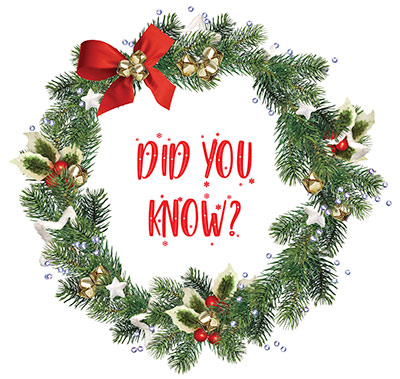Part 1 - The Christmas Wreath
 By Jan White
By Jan White
This email address is being protected from spambots. You need JavaScript enabled to view it.
It’s widely believed that we owe the custom of hanging Christmas wreaths to the Germans, who also began the tradition, as we know it, of decorating Christmas trees in their homes. During the preparation process of trimming the tree to make it more symmetrical, the excess boughs were woven into circular wreaths. The word “wreath” itself is derived from an old English word meaning “twist.” Initially, the wreaths served as ornaments on the tree – not individual decorations as we know them. The circular shape made them easy to hang on the tree and, for many, represented the eternal nature of God -- with no beginning and no end.
Christmas wreaths are also connected with a holiday celebrated by Germanic and Scandinavian people, called “Yule.” The twelve-day festival also called “Midwinter” marked the return of the sun and the promise of spring. The woven tree boughs symbolized nature and were lit with candles representing warmth and the sunlight. From December 17 through 23, Rome also held a Saturnalia celebration, where they worshipped Saturn, the god of agriculture. During the Saturnalia, Romans used holly wreaths as decorations and gave them as gifts.
Related Articles
The concept of the Advent wreath is credited to Johann Hinrich Wichern, the pastor of a Lutheran Church in Germany. The story goes that the children who attended a mission school founded by Wichern would ask him each day when Christmas would arrive. The pastor created a large wooden ring out of an old cartwheel. On the ring, he placed twenty small red and four large white candles. A small candle was lit each day successively, and on Sunday, a white candle was lit, thus providing a visual countdown to Christmas Day. Today, the Advent wreath generally holds four candles, one lit on Sunday for the four weeks preceding Christmas Day. Traditions vary, but typically three of the candles are purple and represent peace, hope, and love. The fourth candle is pink and symbolizes the joy that a Savior was born. Sometimes there is a fifth candle called the “Christ Candle,” which is lit on Christmas Eve.
Not all wreaths are religious in nature. These days, the Christmas wreath is widely thought of as simply a symbol of the holiday spirit. Although the tradition began using hardy evergreens,
the Christmas wreath has seen its own evolution over the decades. With the invention of polyester and plastic materials, fresh greenery gave way to durable artificial wreaths and paved the way for creative alternatives. Who can forget the red cellophane wreaths from the 50s, the ceramic table-top wreaths with tiny lights popular in the 60s, or colorful fabric wreaths from the 70s? Each decade seems to have its “signature” Christmas wreath that reflects its era.
Whether constructed from fresh evergreens, assembled from treasured Christmas ornaments, or made out of red and green bandanas laced around a metal frame, go out and find a Christmas wreath that makes you happy, and celebrate the joy of the season.

